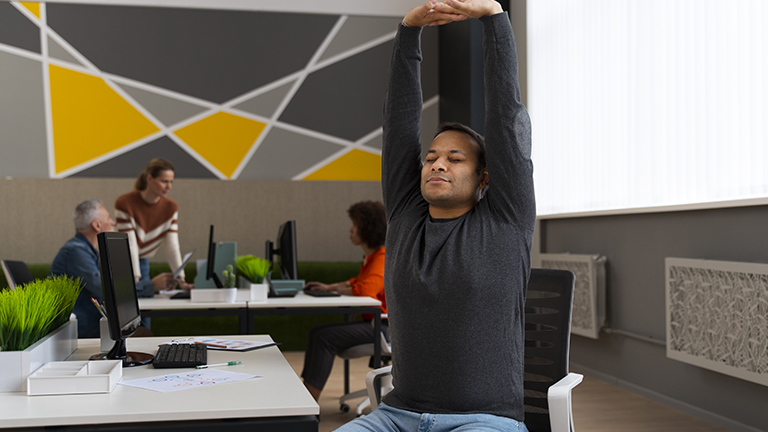Best Stretching Routine for Desk Workers: Modern office culture has dramatically changed the way we move. Millions of people across the USA, UK, Canada, and globally spend eight to ten hours sitting in front of a computer every day. While technology has made work more convenient, the reality is that prolonged sitting brings negative health effects. Desk workers often experience neck stiffness, tight shoulders, poor posture, lower back pain, and hip discomfort. Over time, these issues can lead to chronic musculoskeletal conditions, decreased flexibility, and reduced productivity.
A stretching routine is not just a fitness activity—it is a preventive and restorative practice designed to combat the harmful effects of sitting too long. Stretching increases blood flow, loosens tight muscles, and improves mobility. For desk workers, incorporating a simple daily stretching routine can mean fewer aches, better concentration, and long-term health benefits.
Benefits of Stretching for Office Workers
Stretching offers far more than just temporary relief. When performed consistently, it creates lasting improvements in overall well-being. For desk workers who spend extended hours in front of a screen, stretching helps reset the body. It counteracts the slouching posture that develops when sitting at a desk for long periods. Neck and shoulder stretches can reduce muscle tension, while hip flexor stretches open up the lower body that tends to tighten from constant sitting.
Another significant benefit of stretching is improved circulation. Sitting restricts blood flow, leading to fatigue and discomfort. A few minutes of stretching stimulates blood circulation, delivering oxygen and nutrients to muscles and the brain. This improves focus and productivity during working hours. Stretching also helps reduce stress by activating the parasympathetic nervous system, which promotes relaxation.
For desk workers aiming to improve posture, maintain flexibility, and reduce the risk of injuries, a structured stretching routine is one of the most effective and low-cost solutions available.
[INSERT_ELEMENTOR id=”5108″]
Best Stretching Routine for Desk Workers
The best stretching routine for desk workers focuses on the areas most affected by prolonged sitting: the neck, shoulders, back, hips, and legs. A daily stretching program does not need to be time-consuming. Just 10 to 20 minutes per day can create remarkable changes in mobility, posture, and energy levels.
An ideal stretching routine should include exercises for spinal mobility, neck flexibility, shoulder release, hip opening, and hamstring lengthening. These stretches can be performed either at the desk or in a small open space in the office. Many office workers find that incorporating stretching breaks throughout the day provides consistent relief and prevents stiffness from building up.
Consistency is key. By performing stretches every day, the body gradually adapts, and flexibility improves over time. Desk workers who commit to a routine experience fewer headaches, less back pain, and a noticeable improvement in posture.
Simple Stretches You Can Do at Your Desk
Desk stretches are designed to be convenient and office-friendly. Even if you cannot leave your chair, there are movements that can be performed without drawing attention. Simple neck stretches involve tilting the head from side to side to release tension. Shoulder rolls help release stiffness in the upper body. Seated spinal twists are excellent for restoring mobility in the spine after long periods of sitting.
Hip flexor stretches are also crucial for office workers. Sitting shortens the hip flexors, which can lead to back pain and tightness in the pelvis. A seated figure-four stretch, where one ankle is placed over the opposite knee, helps open the hips. Leg extensions under the desk can also reduce stiffness in the hamstrings.
These stretches may seem simple, but when practice regularly, they significantly reduce muscle tightness and increase comfort during long workdays.
Morning vs Evening Stretches for Office Employees
Stretching routines can be adapted to different times of the day depending on your needs. Morning stretches prepare the body for the day ahead. They wake up stiff muscles, improve circulation, and set a positive tone for posture. Gentle neck rolls, shoulder stretches, and hamstring stretches are excellent for energising the body before starting work.
Evening stretches, on the other hand, are designed to relax the body and release the tension accumulated throughout the day. After hours of sitting, the back, shoulders, and hips need extra attention. Deep hip openers, seated forward bends, and chest-opening stretches are perfect for winding down. Evening routines help reduce stress and promote better sleep by calming the nervous system.
Both morning and evening stretching routines provide benefits, and many desk workers choose to do shorter stretches in the morning and longer sessions after work to maximise results.
How Long Should Desk Workers Stretch Daily?
The length of time spent stretching depends on the individual’s schedule and needs. For most desk workers, stretching for 10 to 15 minutes in the morning and another 10 to 15 minutes in the evening is sufficient. If time is limited, even five-minute desk stretch breaks every two to three hours can make a noticeable difference.
The key factor is not duration but consistency. Short but frequent stretching sessions keep the muscles flexible throughout the day. Over time, these short breaks prevent stiffness from building up and reduce the risk of chronic pain conditions.
Workers who integrate stretching into their daily lifestyle often find that they naturally sit with better posture, feel less fatigued, and recover more quickly from long workdays.
Common Mistakes to Avoid When Stretching at Work
While stretching is generally safe, there are mistakes that desk workers should avoid to prevent discomfort or injury. The most common mistake is rushing through stretches without proper breathing. Stretching should be done slowly, holding each position for at least 20 to 30 seconds to allow muscles to release tension.
Another mistake is overstretching. Pushing the body beyond its natural limits can strain muscles and joints. Instead, stretches should be gentle and within a comfortable range of motion. Skipping certain body parts is also a common error. Many desk workers focus only on neck and shoulders but neglect the hips, hamstrings, and lower back, which also suffer from prolonged sitting.
By avoiding these mistakes and practising with awareness, stretching becomes safer and more effective for long-term results.
Office-Friendly Stretching Tips for Busy Professionals
For professionals with hectic schedules, finding time for stretching may seem challenging. However, with small adjustments, stretching can be seamlessly integrated into the workday. Setting reminders to stand and stretch every hour is one effective strategy. Many office workers also benefit from apps designed to guide short stretching routines.
Another tip is to combine stretching with daily habits. For example, while waiting for a meeting to begin, practice seated shoulder rolls. During a phone call, try standing up and doing gentle hip stretches. These small actions add up and ensure that the body does not remain locked in one position all day.
Wearing comfortable clothing or adjusting posture in an ergonomic chair can also make stretches easier to perform at work. The key is to view stretching not as an extra task but as a natural part of the workday.
Combining Stretching with Ergonomic Adjustments
While stretching is powerful, it is even more effective when combined with ergonomic improvements. Desk workers who sit in poorly adjusted chairs or use non-ergonomic desks may find that stretching provides only temporary relief. Adjusting chair height, screen level, and desk setup ensures that the body maintains proper alignment throughout the day.
An ergonomic workstation reduces unnecessary strain on the spine, neck, and shoulders. Combined with a daily stretching routine, this creates the foundation for long-term musculoskeletal health. Many companies in the USA, UK, and Canada now encourage ergonomic awareness and provide adjustable office furniture to support employees.
This combination of stretching and ergonomics creates a workplace environment that supports health, comfort, and productivity.
Long-Term Benefits of a Daily Stretching Routine
The long-term benefits of stretching go beyond immediate relief from pain and stiffness. For desk workers who commit to a consistent routine, improvements in posture become more noticeable. A straight spine and open chest reduce the risk of chronic back and neck pain. Increased flexibility also lowers the chances of developing repetitive strain injuries that are common among computer users.
Stretching also enhances mental well-being. Desk workers who stretch regularly report higher energy levels, reduced stress, and improved focus. This directly translates into greater productivity at work. Over time, stretching becomes a form of self-care that balances the physical and mental demands of office life.
Whether you are in the USA, UK, Canada, or working remotely anywhere in the world, investing in a stretching routine is one of the simplest and most effective ways to improve health and quality of life as a desk worker.
Neck and Shoulder Stretches for Desk Jobs
Neck and shoulders are the first areas to show tension when sitting for long periods. Desk workers often develop a forward-head posture, which strains the cervical spine. Gentle neck tilts, chin tucks, and lateral stretches help restore alignment. Shoulder rolls and cross-body stretches loosen tight muscles and improve circulation.
These stretches can be performed multiple times throughout the day without leaving the desk. Over time, they reduce the likelihood of headaches and chronic stiffness in the upper body.
Lower Back Pain Relief Stretches
Lower back pain is one of the most common complaints among desk workers. Prolonged sitting compresses the lumbar spine and weakens supporting muscles. Stretching helps relieve this pressure and strengthens flexibility in the lower body. Seated spinal twists, cat-cow movements, and standing forward bends are particularly effective.
Regular lower back stretches reduce discomfort, improve posture, and prevent long-term injuries such as herniated discs or sciatica.
Hip Flexor and Leg Stretches for Desk Workers
Hip flexors are among the tightest muscles for office employees due to constant sitting. This tightness contributes to back pain and poor posture. Hip-opening stretches such as lunges, seated figure-four stretches, and standing quad stretches are essential for releasing tension.
Leg stretches, especially hamstring and calf stretches, also play an important role in maintaining balance in the lower body. Flexible legs support spinal alignment and make sitting for long periods less harmful.
Quick 5-Minute Desk Stretching Routine
For workers with little time, a five-minute routine can still provide relief. Start with gentle neck tilts and shoulder rolls, followed by a seated spinal twist. Extend one leg at a time under the desk to stretch hamstrings. Finish with a seated figure-four stretch to release the hips.
This mini routine can be done between meetings or during short breaks, making it one of the most practical ways to stay active in an office setting.
Best Stretching Apps and Guides for Office Workers
Technology can support desk workers in maintaining a consistent stretching routine. Several apps provide guided stretching sessions tailored to office needs. These apps send reminders and demonstrate stretches through videos or animations. Popular options in the USA, UK, and Canada include apps that focus specifically on posture correction, back pain relief, and desk-friendly exercises.
For those who prefer offline guidance, many health websites and ergonomic specialists provide printable stretching guides that can be kept at the desk. These resources ensure that even the busiest professionals can access safe and effective routines.
Expert Recommendations for Desk Stretching
Physiotherapists and occupational health experts universally recommend stretching for desk workers. According to experts, stretching every hour prevents stiffness and improves musculoskeletal health. They emphasise the importance of targeting the entire body, not just the neck and shoulders.
Experts also suggest combining stretching with light movement, such as short walks around the office, to further improve circulation. For individuals experiencing persistent pain, consulting a healthcare professional for personalised stretching recommendations is advised.




